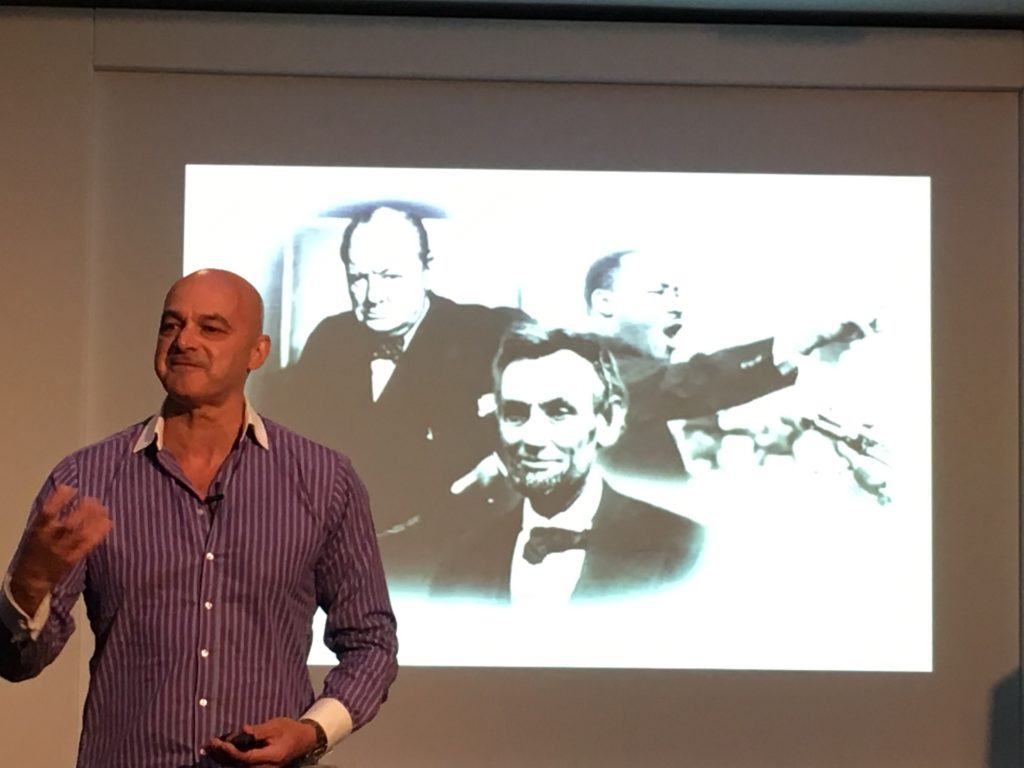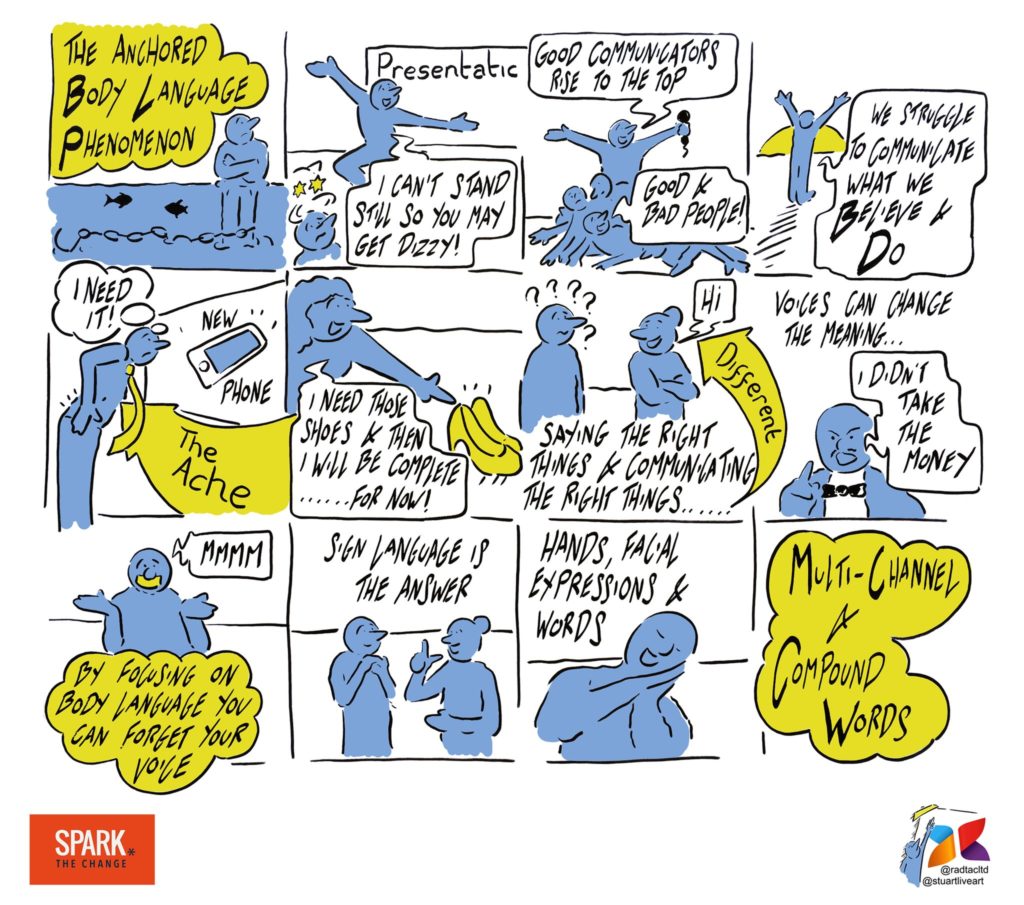by Jennifer Riggins
“I didn’t steal the money.”
This five-word sentence is a loaded one, which varies depending on which word you emphasize. Go ahead, try saying it out loud (preferably not in line at a bank.) If you emphasize the first word, you imply that it was someone else and you might know just who done it. If you emphasize the helping verb, you are simply proclaiming your innocence. If you say “I didn’t steal the money,” it seems “borrowed” it (with or without the intent to return.” And if you emphasize the object, well, you didn’t steal the money, but you just may have swiped something else.
“A tweak in a voice can entirely change what we’re communicating,” comms and body language expert Paul Martin told us at his talk at last week’s Spark the Change conference here in London.

“Good communicators rise to the top,” Paul said, but “We often suffer when we try to communicate what we believe or feel.”
The challenge comes when you are trying to communicate something you’re passionate about and can’t quite get that passion across, or, vice versa — and we would say you should probably leave that job — if you have to sell something that you just feel no passion for. Paul said this is a common barrier to cross — and for us solopreneurs or micro-businesses, one that we have to overcome for success.
When this passion is well-communicated, it creates what he calls “The Ache” or “The Want,” offering Apple as a great example of this. After all, I too lined up for the iPhone 6s, for reasons I couldn’t even describe (and still felt ridiculous doing.)
The anchored body language phenomenon
That old saying, “It’s not what you say, but what you do,” has more than a ring of truth to it. Paul pointed out how each human being communicates:
- non-verbal — 55 percent
- vocal/voice — 38 percent
- verbal — 7 percent
We focus so much on what we say, but in the end, it matters by far the least to our communication.
Paul explained that “Body language is an instinctive language [which] is also not linked to what you’re saying — it’s linked to your feelings and emotions. If you don’t feel what you think in what you’re saying, then body language betrays. If you believe in it, you’ll get complimentary language.”
The problem is that we often fail at multitasking even in our own communication. He described it as what Daniel Kahneman calls “cognitive overload.”.
This is when Paul led the audience into our own cognitive overload, starting by having us rhythmically clapping along with him. Then, he had us look at five random numbers on a screen to later recite in opposite order. Both tasks were simple, until we tried to combine the two conscious actions together, when none of us could recall either pattern, unable to preform two conscious actions at the same time.
He gave another example you can even try by yourself of how we each have our own natural walking pace, which allows us to think clearly. But if we were to consciously speed up that pace even a teensy bit, we lose the ability to think and walk at the same time.
Paul did say there is one way we can overcome those cognitive barriers to become more instinctively persuasive, authentic and passionate communicators — learn sign language.
How learning sign language allows you to be a better communicator
Sign language started out as a way for the hearing impaired to communicate, but it’s more recently been used to improve and emphasize communication in many situations. A lot of research has come out over the last couple years that you can teach babies to communicate faster by teaching them sign language. As early as six months old, through sign, a baby is able to communicate his or her needs. Sign language also helps give a voice to people who have difficulty communicating, like those with autism.
There are dozens of other practical uses for sign language, but for anyone at any age, Paul explained that learning sign helps you become a better communicator because the natural limitations of this language — or languages, since even the U.S. and U.K. have dramatically different languages — actually help you be more emotive. This is because sign language isn’t just the hand gestures but the emotions expressed behind them.
“You don’t have signs for ‘very’. You change intensity with body language,” explained Paul. Sign language is expressed with a combination of the spoken words, the signs, and your facial expression. And the combination of these three aspects are brought together to create compound signs that express everything more clearly and, dare I say, more dramatically.
What Paul’s talk immediately reminded me of was a dynamic new friend Vivian that I met in this great coffee shop and creative space I sometimes work from. Vibrant Vivian always passionately talks about how she loves both her job and her younger brother who happens to be deaf, and I would say very clearly, life in general. She is simultaneously bilingual as she both signs and speaks out loud with anyone she talks to, as well as expresses herself with a lot of smiles, dancing and hugging. Paul’s talk just made me want to know more about Vivian, so I asked her.
Vivian Namagembe (as I learned is her last name) had a stroke when she was younger which left her in a coma and then losing her voice for two years, which is when she learned to sign. Vivian works mornings at a day center for older adults who are there to socialize. She says they can all hear, but the signing allows them to understand her more clearly and that “I’m like sunshine to them.”
Vivian thinks very clearly that everyone should learn sign language because “It makes you more clever” and able to communicate clearly no matter where you are. And I’m inclined to agree with her.
But of course what you say does matter
When trying to communicate better, it’s not just your body language. You also have to use the power of your voice and your spoken language to project your passion. Everything you communicate should include:
- Vocabulary – relevant to the industry your audience is from
- Feelings – and, if you don’t know how you feel yourself, how could you possibly communicate it?
- Expressing feelings/emotions
- And then instinctively connecting it all together
But does it really work? Paul had started off his talk introducing us to a Cable TV salesman who was ranked 191 among thousands across the country, which isn’t bad. But he happened to work next to the person who made top sales rep year after year. They both may have been following the same script, but Mr. #1 was selling a different lifestyle with a whole new level of passion. Mr. #191 took Paul’s workshop before being told not to give it another thought as he went back to work. The next year he became #7 overall. His effective communication, body language, and infectious passion had become instinctual.
Paul says that’s because better communication “changes the way people respond to you — they become more empathetic [which] feeds your propensity to become even better communicators.”
As Paul said, by focusing on your body language, you can never forget your voice.
What tricks have you learned to better communicate your brand and, most importantly, your value? Share your tricks with us in the comments below!



Hi, great article!
My two cents 😉 there is one understatement –
non-verbal — 55 percent, vocal/voice — 38 percent, verbal — 7 percent – it’s from Mehrabian experiments, and Mehrabian said: “Please note that this and other equations regarding relative importance of verbal and nonverbal messages were derived from experiments dealing with communications of feelings and attitudes (i.e., like–dislike)”
more links: https://en.wikipedia.org/wiki/Albert_Mehrabian http://www.presentwithease.com/the-mehrabian-myth.html http://eloquentwoman.blogspot.com/2009/07/busting-mehrabian-myth-words-matter.html
I agree that communication is the key and non-verbal part is crucial one, but without one detailing we can popularise that “myth”
Best regards,
Marcin
Nice to know that VIV is shining even more as she communicates. Long journey.
I never realized that learning sign language can help you become more emotive and a better communicator overall. I like that you mention how sign language is a combination of works, signs, and facial expressions. Having a mixture of all these things in all forms of communication would definitely make you a more expressive speaker I bet. Thanks for sharing!